
Hot search terms: 360 Security Guard Office365 360 browser WPS Office iQiyi Huawei Cloud Market Tencent Cloud Store

Hot search terms: 360 Security Guard Office365 360 browser WPS Office iQiyi Huawei Cloud Market Tencent Cloud Store

video editing Storage: 4.8GB Time: 2021-11-12
Software introduction: VideoStudio (Corel VideoStudio) is a feature-rich video editing software released by the Canadian Corel company. Videophone...
How to set the custom size of VideoStudio X8? If you use VideoStudio to make videos, many steps require custom actions to set, such as size, position, border, etc., all of which must be completed with custom actions. So the editor below will introduce you to the use of custom actions in VideoStudio X8. Please see below for details!
How to use VideoStudio X8 custom actions:
1. Position, size and rotation settings
This part of the settings is the most commonly used in customization
1. First add a piece of material to the video track, then right-click the material and click the Custom Action option.
2. In the custom action that pops up, see parameter settings such as "Position", "Size", and "Occlusion" on the left.
3. Position value. When the X-axis is negative, the material appears on the left side of the screen, as shown in Figure 1. When the value is positive, it appears on the right side of the screen.
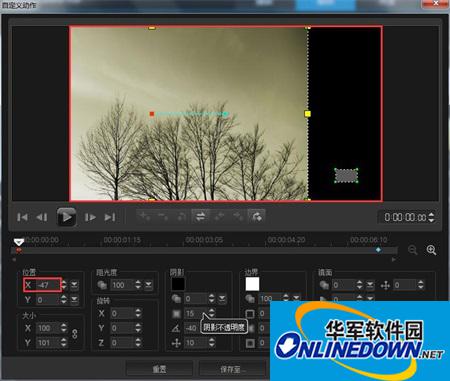
4. When the Y-axis is negative, the material appears at the bottom of the screen, otherwise it appears at the top of the screen.
5. Size setting. Adjusting the X and Y axis values is the size of the material displayed on the screen. Unlocking "Unlock Aspect Ratio" allows you to adjust the X and Y axis values independently.

6. Blockage setting. Occupancy actually means transparency. The smaller the value, the darker the image, the larger the value, the brighter the image.
7. Rotation settings. The X-axis setting is to rotate along the X-axis, that is, flip up and down, as shown in Figure 3. The Y axis rotates along the Y axis, that is, flips left and right. The Z axis is flipped along the Z axis, which is flipping on the screen.
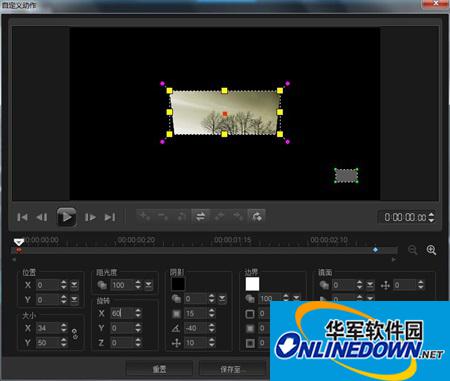
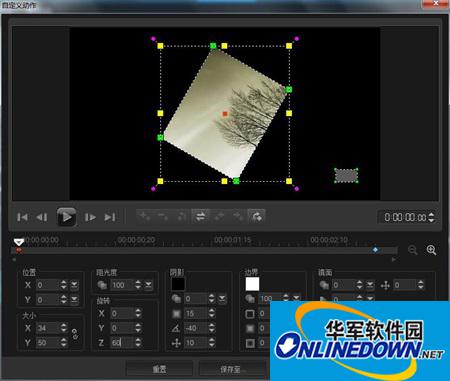
2. Shadow and border settings
Shadows and borders are the most commonly used settings when making electronic photo albums. This function is actually similar to VideoStudio Picture-in-Picture.
1. Shadow settings. The black bar at the top allows you to adjust the color of the shadow. Shadow opacity means the same thing as opacity. Shadow blur is the degree to which shadow boundaries are stencilled. The shadow direction is the direction in which the shadow deviates from the material, as shown in Figure 5. Shadow distance is the distance between the shadow and the material.

2. Boundary setting. In the white frame, you can adjust the color of the border. Border opacity is the same as described above. The larger the border size value, the larger the border. The border template fade value is the degree of feathering of the outer border. The border template fade-in value is the degree of feathering of the inner border.
3. Mirror and ease-in/ease-out settings
1. The mirror is the reflection of the material. Mirror opacity needs no introduction. Specular distance is the distance between the reflection of the material and the material. The larger the value, the further the distance. Mirror fade is the degree to which the reflection fades. The larger the value, the darker the mirror, as shown in Figure 6.
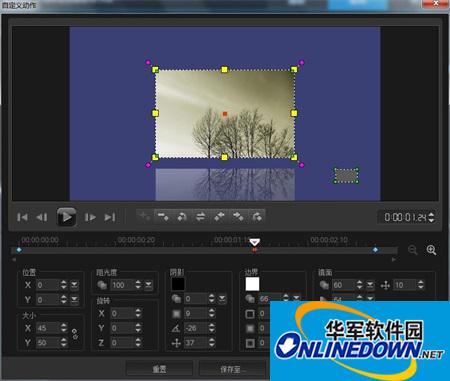
2. Ease in/ease out settings. It is the speed at which the material enters the screen. Click the ease in or ease out button, adjust the slide rail, and adjust the speed, as shown in Figure 7.
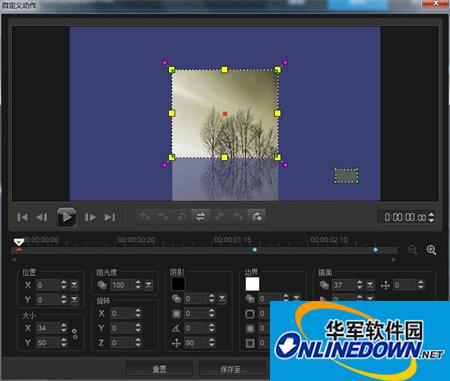
The setting of custom actions is actually mainly composed of the above three parts. The first part is the most commonly used. If you use it in the video production process, I believe everyone will find this function powerful. I hope the editor's introduction can help everyone!
The editor recommends:
How to set custom video filters on VideoStudio X8?
How to create a 10-second countdown video on VideoStudio X8?
How to quickly capture videos with VideoStudio X8?
 How does coreldraw export the specified object as a picture - How does coreldraw export the specified object as a picture
How does coreldraw export the specified object as a picture - How does coreldraw export the specified object as a picture
 How to adjust word spacing in coreldraw - How to adjust word spacing in coreldraw
How to adjust word spacing in coreldraw - How to adjust word spacing in coreldraw
 How to use Bezier tools in coreldraw - How to use Bezier tools in coreldraw
How to use Bezier tools in coreldraw - How to use Bezier tools in coreldraw
 How to adjust font color in coreldraw - How to adjust font color in coreldraw
How to adjust font color in coreldraw - How to adjust font color in coreldraw
 How to mirror symmetry in coreldraw - How to mirror symmetry in coreldraw
How to mirror symmetry in coreldraw - How to mirror symmetry in coreldraw
 Eggman Party
Eggman Party
 WPS Office 2023
WPS Office 2023
 WPS Office
WPS Office
 Minecraft PCL2 Launcher
Minecraft PCL2 Launcher
 WeGame
WeGame
 Tencent Video
Tencent Video
 Steam
Steam
 CS1.6 pure version
CS1.6 pure version
 Office 365
Office 365
 What to do if there is no sound after reinstalling the computer system - Driver Wizard Tutorial
What to do if there is no sound after reinstalling the computer system - Driver Wizard Tutorial
 How to switch accounts in WPS Office 2019-How to switch accounts in WPS Office 2019
How to switch accounts in WPS Office 2019-How to switch accounts in WPS Office 2019
 How to clear the cache of Google Chrome - How to clear the cache of Google Chrome
How to clear the cache of Google Chrome - How to clear the cache of Google Chrome
 How to practice typing with Kingsoft Typing Guide - How to practice typing with Kingsoft Typing Guide
How to practice typing with Kingsoft Typing Guide - How to practice typing with Kingsoft Typing Guide
 How to upgrade the bootcamp driver? How to upgrade the bootcamp driver
How to upgrade the bootcamp driver? How to upgrade the bootcamp driver